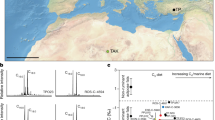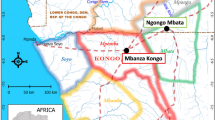Abstract
Pottery was a hunter-gatherer innovation that first emerged in East Asia between 20,000 and 12,000 calibrated years before present1,2 (cal bp), towards the end of the Late Pleistocene epoch, a period of time when humans were adjusting to changing climates and new environments. Ceramic container technologies were one of a range of late glacial adaptations that were pivotal to structuring subsequent cultural trajectories in different regions of the world, but the reasons for their emergence and widespread uptake are poorly understood. The first ceramic containers must have provided prehistoric hunter-gatherers with attractive new strategies for processing and consuming foodstuffs, but virtually nothing is known of how early pots were used. Here we report the chemical analysis of food residues associated with Late Pleistocene pottery, focusing on one of the best-studied prehistoric ceramic sequences in the world, the Japanese Jōmon. We demonstrate that lipids can be recovered reliably from charred surface deposits adhering to pottery dating from about 15,000 to 11,800 cal bp (the Incipient Jōmon period), the oldest pottery so far investigated, and that in most cases these organic compounds are unequivocally derived from processing freshwater and marine organisms. Stable isotope data support the lipid evidence and suggest that most of the 101 charred deposits analysed, from across the major islands of Japan, were derived from high-trophic-level aquatic food. Productive aquatic ecotones were heavily exploited by late glacial foragers3, perhaps providing an initial impetus for investment in ceramic container technology, and paving the way for further intensification of pottery use by hunter-gatherers in the early Holocene epoch. Now that we have shown that it is possible to analyse organic residues from some of the world’s earliest ceramic vessels, the subsequent development of this critical technology can be clarified through further widespread testing of hunter-gatherer pottery from later periods.
This is a preview of subscription content, access via your institution
Access options
Subscribe to this journal
Receive 51 print issues and online access
$199.00 per year
only $3.90 per issue
Buy this article
- Purchase on Springer Link
- Instant access to full article PDF
Prices may be subject to local taxes which are calculated during checkout



Similar content being viewed by others
References
Wu, X. et al. Early pottery at 20,000 years ago in Xianrendong Cave, China. Science 336, 1696–1700 (2012)
Nakamura, T., Taniguchi, Y., Tsuji, S. & Oda, H. Radiocarbon dating of charred residues on the earliest pottery in Japan. Radiocarbon 43, 1129–1138 (2001)
Bailey, G. N. & Flemming, N. C. Archaeology of the continental shelf: marine resources, submerged landscapes and underwater archaeology. Quat. Sci. Rev. 27, 2153–2165 (2008)
Jordan, P. & Zvelebil, M. Ceramics before Farming: The Dispersal of Pottery Among Prehistoric Eurasian Hunter-Gatherers (Left Coast, 2009)
Keally, C. T., Taniguchi, Y., Kuzmin, Y. V. & Shewkomud, I. Y. Chronology of the beginning of pottery manufacture in East Asia. Radiocarbon 46, 345–351 (2004)
Jordan, P. & Zvelebil, M. in Ceramics Before Farming: The Dispersal of Pottery Among Prehistoric Eurasian Hunter-Gatherers (eds Jordan, P. & Zvelebil, M. ) 33–90 (Left Coast, 2009)
Keally, C. T., Taniguchi, Y. & Kuzmin, Y. V. Understanding the beginnings of pottery technology in Japan and neighboring East Asia. Rev. Archaeol. 24, 3–14 (2003)
Rice, P. M. On the origins of pottery (ceramic technology among complex hunter-gatherers). J. Archaeol. Method Theory 6, 1–54 (1999)
Ikawa-Smith, F. On ceramic technology in East Asia. Curr. Anthropol. 17, 513–515 (1976)
Evershed, R. P. Organic residue analysis in archaeology: the archaeological biomarker revolution. Archaeometry 50, 895–924 (2008)
Regert, M. Analytical strategies for discriminating archeological fatty substances from animal origin. Mass Spectrom. Rev. 30, 177–220 (2011)
Evershed, R. P. et al. Earliest date for milk use in the Near East and southeastern Europe linked to cattle herding. Nature 455, 528–531 (2008)
Craig, O. E. et al. Did the first farmers of central and eastern Europe produce dairy foods? Antiquity 79, 882–894 (2005)
Craig, O. E. et al. Ancient lipids reveal continuity in culinary practices across the transition to agriculture in Northern Europe. Proc. Natl Acad. Sci. USA 108, 17910–17915 (2011)
Isaksson, S. Vessels of change: a long-term perspective on prehistoric pottery-use in southern and eastern middle Sweden based on lipid residue analyses. Curr. Swedish Archaeol. 17, 131–149 (2009)
Taniguchi, Y. The beginning of the early Jōmon. Ibou 20, 2–36 (2002)
Ono, A., Sato, H., Tsutsumi, T. & Kudo, Y. Radiocarbon dates and archaeology of the Late Pleistocene in the Japanese islands. Radiocarbon 44, 477–494 (2002)
Craig, O. E. et al. Molecular and isotopic demonstration of the processing of aquatic products in northern European prehistoric pottery. Archaeometry 49, 135–152 (2007)
Morton, J. D. & Schwarcz, H. P. Palaeodietary implications from stable isotopic analysis of residues on prehistoric Ontario ceramics. J. Archaeol. Sci. 31, 503–517 (2004)
Hansel, F. A., Copley, M. S., Madureira, L. A. S. & Evershed, R. P. Thermally produced ω-(o-alkylphenyl) alkanoic acids provide evidence for the processing of marine products in archaeological pottery vessels. Tetrahedr. Lett. 45, 2999–3002 (2004)
Craig, O. E. et al. Distinguishing wild ruminant lipids by gas chromatography/combustion/isotope ratio mass spectrometry. Rapid Commun. Mass Spectrom. 26, 2359–2364 (2012)
Tanabe, S., Nakanishi, T. & Yasui, S. Relative sea-level change in and around the Younger Dryas inferred from late Quaternary incised-valley fills along the Japan Sea. Quat. Sci. Rev. 29, 3956–3971 (2010)
Kudo, Y. & Kumon, F. Paleolithic cultures of MIS 3 to MIS 1 in relation to climate changes in the central Japanese islands. Quat. Int. 248, 22–31 (2012)
Hayden, B. in The Emergence of Pottery (eds Barnett, W. K. & Hoopes, J. W. ) 257–266 (Smithsonian Institution, 1995)
Faure, H., Walter, R. C. & Grant, D. R. The coastal oasis_ ice age springs on emerged continental shelves. Global Planet. Change 33, 47–56 (2002)
Kaner, S. in Ceramics Before Farming: The Dispersal of Pottery Among Prehistoric Eurasian Hunter-Gatherers (eds Jordan, P. & Zvelebil, M. ) 93–119 (Left Coast, 2009)
Craig, O. E., Love, G. D., Isaksson, S., Taylor, G. & Snape, C. E. Stable carbon isotopic characterisation of free and bound lipid constituents of archaeological ceramic vessels released by solvent extraction, alkaline hydrolysis and catalytic hydropyrolysis. J. Anal. Appl. Pyrolysis 71, 613–634 (2004)
Hamilton, R. J., Hamilton, S. & Harwood, J. Lipid Analysis: A Practical Approach 53–54 (IRL, 1992)
Regert, M., Bland, H. A., Dudd, S. N., van Bergen, P. F. & Evershed, R. P. Free and bound fatty acid oxidation products in archaeological ceramic vessels. Proc. R. Soc. Lond. B Biol. Sci. 265, 2027–2032 (1998)
Evershed, R. P., Copley, M. S., Dickson, L. & Hansel, F. A. Experimental evidence for the processing of marine animal products and other commodities containing polyunsaturated fatty acids in pottery vessels. Archaeometry 50, 101–113 (2008)
Acknowledgements
We thank the Leverhulme trust (F/00 152/AM) and the Japanese Society for the Promotion of Science (PE 11560) for their support. We are grateful to K. Adachi, K. Higashi, Y. Kasai, H. Kato, K. Nagahama, H. Oguma, T. Tsuchiya, T. Watanabe and T. Yamahara for providing access to samples.
Author information
Authors and Affiliations
Contributions
O.E.C., H.S., Y.N., S.I. and P.J. planned the project. O.E.C. wrote the paper with assistance from all other authors. P.J., H.S., Y.N. and K.G. carried out sampling with assistance of M.A. and J.U., who provided contextual data. O.E.C., H.S., A.L., K.T., D.A. and A.T. carried out the lipid analysis. C.P.H. and L.C. carried out the bulk stable isotope analyses. All authors commented on the manuscript.
Corresponding author
Ethics declarations
Competing interests
The authors declare no competing financial interests.
Supplementary information
Supplementary Information
This file contains Supplementary Tables 1-4 and Supplementary References. Tables 1-4 contain contextual details (including radiocarbon dates) of each of the sites investigated, a summary of the lipid residue analysis results, bulk isotope characteristics of each sample analysed and a summary of the reference isotope values used to derive the fields in Figure 2B. (PDF 280 kb)
Rights and permissions
About this article
Cite this article
Craig, O., Saul, H., Lucquin, A. et al. Earliest evidence for the use of pottery. Nature 496, 351–354 (2013). https://doi.org/10.1038/nature12109
Received:
Accepted:
Published:
Issue Date:
DOI: https://doi.org/10.1038/nature12109
This article is cited by
-
Ceramic production and the transition to agriculture in Northeast China: Neolithic pottery technology in the Fuxin Region
Archaeological and Anthropological Sciences (2024)
-
A ‘Family of Wear’: Traceological Patterns on Pebbles Used for Burnishing Pots and Processing Other Plastic Mineral Matters
Journal of Archaeological Method and Theory (2024)
-
Food, cooking and potteries in the Neolithic Mijiaya site, Guanzhong area, North China, revealed by multidisciplinary approach
Heritage Science (2023)
-
New insights into the use of Neolithic pottery in Guangxi of South China: organic residue analysis of experimental and archaeological pottery
Heritage Science (2023)
-
Henceforth fishermen and hunters are to be restrained: towards a political ecology of animal usage in premodern Japan
Asian Archaeology (2023)
Comments
By submitting a comment you agree to abide by our Terms and Community Guidelines. If you find something abusive or that does not comply with our terms or guidelines please flag it as inappropriate.



